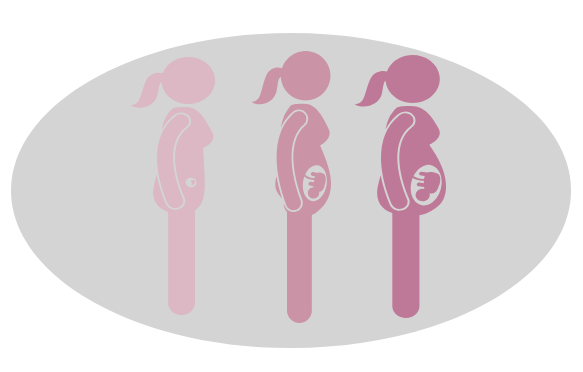What if my patient is pregnant?

Female genital mutilation/cutting (FGM/C) poses unique challenges to pregnant women. Women with some forms of FGM/C may feel no effects at all. Other women, however, may need deinfibulation (opening the vagina) to avoid obstructed labor. The more severe the cutting, the greater the risks to labor and delivery.1
What are the risks associated with FGM/C during pregnancy?
- Excessive bleeding/post-partum hemorrhage1,2
- Obstructed labor (with Type II and Type III)1
- May require cesarean sections1,2
- Prolonged labor1
- Episiotomy2
- Perineal trauma/tears1
- Increased risk of stillbirth or perinatal death, though this is rare2
What if my patient has undergone FGM/C and is pregnant?
- Use prenatal visits to talk about how FGM/C could affect delivery.3
- Start the conversation on how FGM/C could affect labor and delivery with patients who are not yet pregnant but plan to become pregnant in the near future.
- Ask your patient if she had any complications from FGM/C during past pregnancies.
- Discuss deinfibulation, a minor surgical procedure conducted by a licensed health professional to re-open the vaginal opening, if she has Type III FGM/C.
- Manage labial tears among woman with FGM/C the same way you would with women without FGM/C.4
- Check out these additional resources:
- Detailed information on deinfibulation (Arizona State University) (pdf)
- General information on pregnancy and FGM/C (UK Royal College of Obstetrics and Gynecology) (pdf)
- Rushwan H. (2000) Female genital mutilation (FGM) management during pregnancy, childbirth and the postpartum period. International Journal of Gynecology & Obstetrics, 70(1):99-104. (pdf)
Listening to the patient to avoid an episiotomy
A 24-year old pregnant woman with Type I FGM/C (clitoridectomy: the partial or total removal of the clitoris and/or prepuce) walked into a clinic for her prenatal appointment. The patient did not want to deliver via C-section, nor did she want an episiotomy. She strongly desired a vaginal delivery, in her own home. Her health care providers listened and respected her decision. The vaginal delivery proved difficult, however. Scars resulting from the patient's clitoridectomy meant tight skin. The birth was not progressing though the patient was pushing. Success finally came when the health care provider loosened up the scar tissue by massaging the area. The patient tore along the scar tissue of the clitoridectomy. A healthy baby was born with no complications, and with no need for an episiotomy.
In their own words
Health care providers may need to respond to requests for re-infibulation:
When a patient asked me to sew her vagina up again
Read more on how to handle re-infibulation requests:
Policies on Genital Mutilation (AAFP)
Should I perform deinfibulation (re-opening the vagina)?
Warning: The video below contains graphic content. This video shows you how to perform deinfibulation.
-
Type III FGM/C may require deinfibulation.
- Deinfibulation is a procedure that you can perform to improve symptoms resulting from Type III FGM/C. It is a "vertical incision made along the anterior surface of the infibulated scar until the urethral meatus, and eventually the clitoris, are visible."5
- Deinfibulation can prevent obstetric complications among women whose vaginal openings have been sewn shut (Type III FGM/C).6
- Some patients consider deinfibulation culturally unacceptable, fearing their partners may reject them or worrying their vaginas may feel “open” after the procedure has been performed. 7You should discuss risks and benefits of the procedure with the patient preoperatively.8
- Deinfibulation should be performed during the second trimester of pregnancy or during the first stage of labor. 9 Some researchers recommend performing deinfibulation before pregnancy.10
- Perform deinfibulation before an episiotomy, if needed during labor and delivery.4



